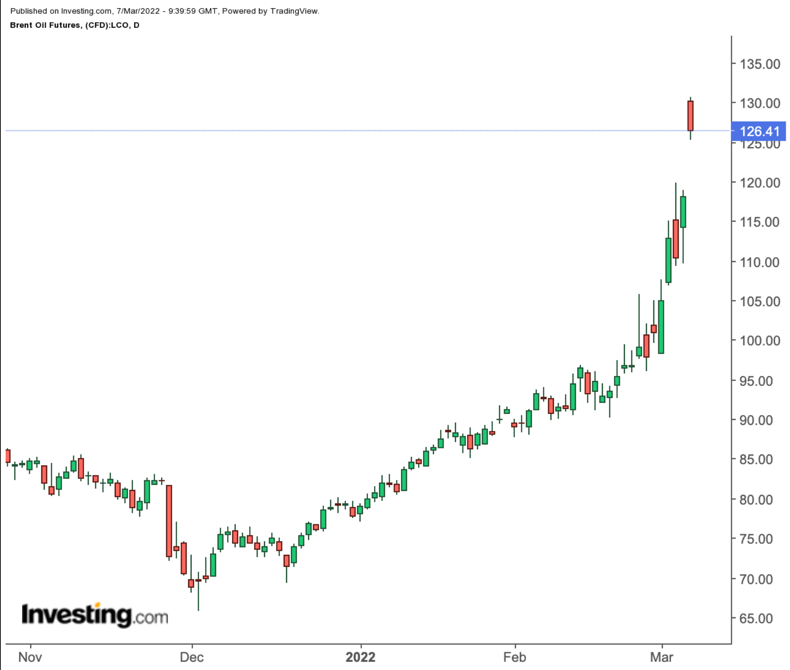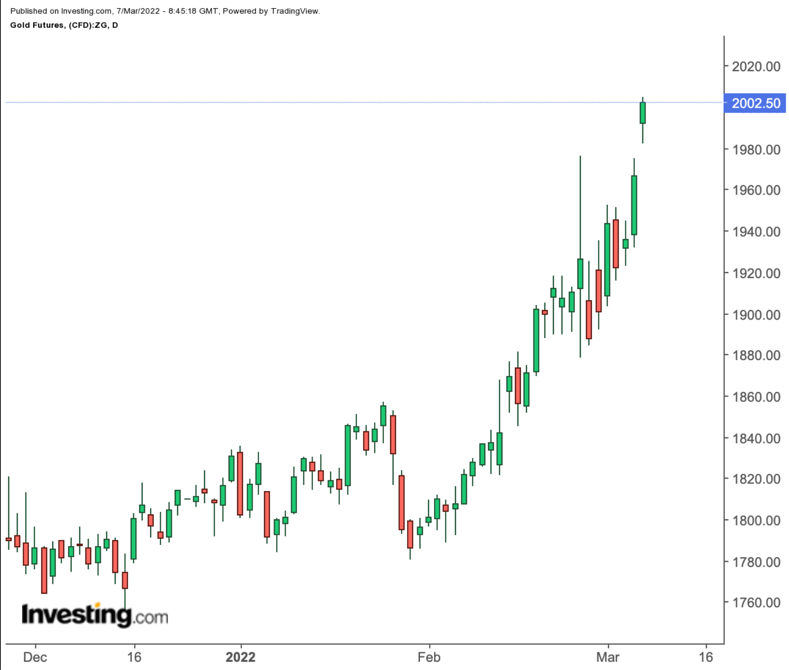The US report card for inflation is likely to have gotten worse in February and the Federal Reserve’s proposed rate hike next week will probably do little to quell this, evidenced by new multi-year highs in oil, gold and other commodity prices on Monday as speculators took advantage of severely squeezed raw material supplies.

Brent Oil surged to 2008 peaks of above $130 a barrel as the fate of Russian oil hung in the balance as the White House considered an import ban due to Moscow’s invasion of Ukraine.
Gold revisited the $2,000-an-ounce high last seen in the summer of 2020—when markets were groping with the still-new coronavirus pandemic—as the safe haven found favor with investors fearing more unknowns over the rest of this year.

Prices of copper to wheat, corn, and soybeans, and even coffee, meanwhile, surged from worries that the Russia-Ukraine crisis might now drag on for months, complicating supply chains that had just begun improving from COVID-19 stress.
“The premise is quite simple, if you pump, dig, or grow stuff out of the ground that the rest of the world needs right now, you are in the driver’s seat,” said Jeffrey Halley, Asia Pacific analyst for online trading platform OANDA.
While the best cure for high prices is probably even higher prices, global growth projections for 2022 might “need to be sharply revised lower, and it will be interesting to see what the central banks of the world will do,” Halley said.
He said he was highly concerned about the stagflationary wave sweeping across the globe, especially “for the poor countries of the world who will suffer the most.”
Halley added:
“I believe Europe and Asia will halt thoughts of monetary policy normalization; with Europe on the front lines, I can’t blame them.”
According to a note from Goldman Sachs, a sustained $20 oil rise shock will lower real economic growth in the euro area by 0.6% and by 0.3% in the United States. Oil prices have risen by roughly $50 since the year began.
The Fed, which comes on next week with its first pandemic-era rate hike, could call for an increase of just a quarter percentage point if Chairman Jerome Powell and the more dovish members of the central bank’s policy-making Federal Open Market Committee have their way.
Last week, as US Crude prices were still in the $105-$115 range, Powell said about the importance of shutting out the noise of high but temporary oil price spikes from inflationary calculations.
“If you have an oil spike and it just comes and goes, it won’t actually affect ongoing inflation,” the Fed chair said, explaining why he was veering toward a moderate 25 basis point or quarter percentage point for the FOMC’s forthcoming Mar. 15-16 meeting. But if the oil price gains are persistent, “then that’s a different thing. And we’re much more concerned at the latter,” Powell added.
Wall Street bank UBS estimates that a $10 jump in oil equates to anywhere between 25 and 40 basis points of inflation. Fed Chair Powell’s calculation for the same is two-tenths inflation.
US Feb Inflation Report Unlikely To Be Comforting
Regardless of what Powell thinks, the US Consumer Price Index reading for February—due on Thursday—is unlikely to be comforting.
The consensus is that the CPI grew last month by a pace of 7.9% year-on-year. And many economists think that might be a conservative estimate. January’s year-on-year growth of 7.5% for the CPI was already the highest since 1982.
Powell might have reason to be concerned about high oil prices sticking around for a while because analysts say the only way oil prices are going to fall is by rising even more. It’s not just the adage of the commodity world, that the cure for higher prices is higher prices. With Russian oil virtually blocked by existing sanctions, prices will have to rise because:
- there’s not enough supply to feed the 99 million barrels per day of global demand (as per 2019 records);
- the other major producer—Saudi Arabia—will not stop raising its prices.
In a Friday announcement, Saudi Arabia’s state-owned oil company Aramco (SE:2222) hiked the official selling price (OSP) of its Arab light crude to Asia by a record of $4.95 per barrel versus the Oman/Dubai average which it uses as its base.
In Monday’s Asian trading, Brent, the global benchmark for crude, soared to nearly $131 a barrel in Asian trading—reaching just $17 short of the all-time high of $147.50 in July 2008, before the global markets meltdown that preceded the financial crisis.
Pricey Oil Could Stay Till ‘Demand Destruction’—Whenever That Is
If Russian crude is banned in the US, oil might hit $150 a barrel in the next three months, according to Damien Courvalin, head of energy research at Goldman Sachs.
J.P. Morgan says if the disruption to Russian oil volumes lasts throughout the year, Brent could end 2022 at $185. But at that point, there could also be demand destruction of some 3 million barrels daily, as discretionary road travel or flying becomes too expensive at such prices, says JPM.
According to reports on Monday, the United States is considering acting without allies on a ban on Russian oil imports. However, the timing and scope of any US ban on Russian oil remain uncertain, the reports said.
The truth is the White House has been dragging its feet on sanctioning or putting an outright embargo on Russian oil exports for obvious reasons. Russia exported 10.5 million barrels per day in 2021 and 20% of that went to America alone.
Once a White House ban on Russian oil is in place, a gallon of gasoline could cross $4.50 this week, touching 2008 pre-financial crisis highs and creep toward $5 next. What’s worse would be the forward-going impact of that spike on grocery bills.
Also, some 10% of the world’s crude and 40% of Europe’s gas comes from Russia, meaning America’s pain won’t be in isolation if Asia and Europe decide to join in acting against Moscow.
But Watch Those Overbought Technicals Too In Oil
Notwithstanding the intensity of the oil rally, technicals suggest that both Brent and US crude—which also reached highs of around $130 on Monday—were severely overbought.
“With every passing day, oil is inching closer to trigger a sharp decline targeting $105-$95 initially, with the next leg up to the 2008 all-time high of $147 or back down to $82-$67, depending on the geopolitical factors around oil as well,” said Sunil Kumar Dixit, chief technical strategist at skcharting.com.
In the case of gold, he said the spot price 4-hour chart showed a breakout above the symmetrical triangle formation that targets $2,034 soon after the $2,000 target is cleared, Dixit said.
Spot gold hit a high of $2,000.96 on Monday, versus the all-time high of $2,073.41 in August 2020. Gold futures on New York’s COMEX rose to a session peak of $2,005 against its record high of $2,121.70.
Disclaimer: Barani Krishnan uses a range of views outside his own to bring diversity to his analysis of any market. For neutrality, he sometimes presents contrarian views and market variables. He does not hold a position in the commodities and securities he writes about.
